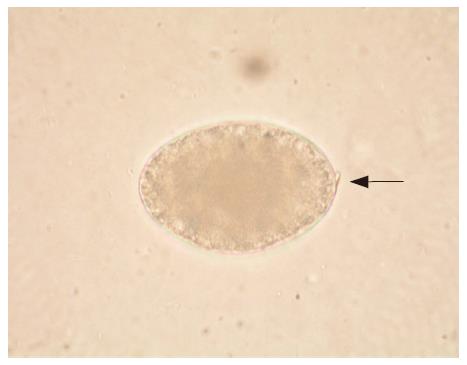Published online Mar 28, 2007. doi: 10.3748/wjg.v13.i12.1875
Revised: December 11, 2006
Accepted: December 13, 2007
Published online: March 28, 2007
Colorectal cancer screening can be performed by fecal occult blood testing, sigmoidoscopy, double contrast barium enema or colonoscopy. Colonoscopy has the significant advantage that polyps can be removed during the same procedure. Occasionally, colonoscopy can also reveal unexpected findings, including parasitic infections, even in asymptomatic patients. Tapeworms or cestodes are hermaphroditic parasites, which can live for considerable periods of time in the human gastrointestinal tract. Fish tapeworm (Diphyllobothrium species) are endemic in various parts of the world, the commonest species being Diphyllobothrium latum. Humans are the main definitive host for D. Latum and the majority of individuals harbouring the parasite are asymptomatic, while 40% of infected individuals may have low vitamin B12 levels. We describe a case of D. latum infection found on routine colonoscopic screening for colorectal cancer in an asymptomatic patient, which was successfully treated with praziquantel. The infection likely arose following raw fish (sushi) consumption.
-
Citation: Lal S, Steinhart AH.
Diphyllobothrium latum : A case of an incidental finding. World J Gastroenterol 2007; 13(12): 1875-1876 - URL: https://www.wjgnet.com/1007-9327/full/v13/i12/1875.htm
- DOI: https://dx.doi.org/10.3748/wjg.v13.i12.1875
Tapeworms or cestodes are hermaphroditic parasites, which can live for considerable periods of time in the human gastrointestinal tract. Fish tapeworm (Diphyllobothrium species) are endemic in various parts of the world, the commonest species being Diphyllobothrium latum.
Colorectal cancer screening can be performed by fecal occult blood testing, sigmoidoscopy, double contrast barium enema or colonoscopy. Colonoscopy has the significant advantage that polyps can be removed during the same procedure. Occasionally, colonoscopy can also reveal unexpected findings, including parasitic infection, even in asymptomatic patients.
A 70-year-old woman, with a family history of colorectal carcinoma, was referred for evaluation of minimal bright red bleeding per rectum. Laboratory data, including complete blood count, serum ferritin, B12 and folate were within normal limits. Colonoscopy revealed first-degree hemorrhoids, with an unusual finding in the ascending colon and terminal ileum (Figure 1A and B).
The colonoscopic images revealed a segmented worm, 2 mm wide, in the ascending colon (Figure 1A), passing through the ileo-caecal valve into the small intestine (Figure 1B). Microscopy of a retrieved portion of the worm showed segments and eggs (Figure 2) characteristic of Diphyllobothrium latum; these typically measure 40 by 60 m and display a small knob or ‘abopercular’ on the opposite end of a lid-like opening or ‘operculum’, which may be inconspicuous. The patient was treated with a single dose of praziquantel. No eggs were seen in stool samples checked one and three months later.
Humans are the main definitive host for D. Latum (broadfish tapeworm), which can measure up to 12 m. Most individuals harboring the parasite are asymptomatic, and 40% may have low B12 levels but only 2% develop anaemia[1]. Freshwater fish act as intermediate hosts and patients consuming raw fish may risk infection, which is the likely source in our patient.
S- Editor Wang J L- Editor Ma JY E- Editor Liu Y
| 1. | Schantz PM. Tapeworms (cestodiasis). Gastroenterol Clin North Am. 1996;25:637-653. [RCA] [PubMed] [DOI] [Full Text] [Cited by in Crossref: 54] [Cited by in RCA: 38] [Article Influence: 1.3] [Reference Citation Analysis (0)] |










